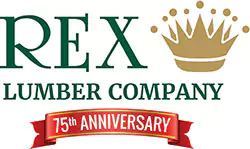Rex Lumber Company has sanding equipment to sand flat boards and panels, as well as a profile sander to sand almost any moulding. The main purpose of sanding is to remove the knife marks left during the mouldings process. Please note all mouldings that are run have knife marks, depending on the profile and specie of wood, knife marks are sometimes more pronounced than others, but they are there. While mouldings are not typically sanded before many paint grade applications, it is strongly recommended that that any material using a high end or glossy finish be sanded prior to finishing.
Sanding
Rex Lumber'sSanders
We have two different sanders in our mill, which allow us to meet the majority of our customers’ needs. The first sander we have is a profile sander. The profile sander consists of nine heads, which are a combination of four belts and five wheels. The sander denibs and sands stock whether the stock is profiled, flat or a combination. The first head on the sander is a belt that is programmed to oscillate to minimize “longitudinal lines” that can often occur with machine sanding. The remaining three belts can be used to sand flats, or they can be shaped using felt pads to sand “slight” profiles. For more detailed profiles, abrasive grit sanding wheels are used. Prior to sanding, the wheels are shaped to mirror the exact profile being sanded. These wheels automatically adjust bi-directionally for wear to provide a consistent finish from the first to last piece. Most profiles are sanded using a combination of wheels and belts. The final head on the machine is a specially designed wheel that blends the finish between the different wheels and belts into a consistent finish over the entire profile.
The Process
Typical sanding uses a stepped approach starting with a coarse grit and moving to a finer grit. Multiple passes are sometimes required at the beginning to remove knife marks and get the desired scratch pattern. Harder woods like Hard Maple may require multiple passes at each grit to be properly sanded. It is not recommended to skip grits in the sequence because irregular scratch patterns will cause stain to absorb differently. Our typical sanding finish is to 150 grit, which is the level of sanding that is generally recommended for finishing. We have the ability to sand to higher/finer grits if a job requires it.
We Can Sand OnOne or Both Faces
Need S4S sanded on one or both faces? No problem, we can do it for you. Our second sander is a wide belt flat sander. This sander is used to sand flat material or wide flats on mouldings like base boards. It uses a single belt to sand one face. If both faces need to be sanded, then the material will need to be sent through the machine multiple times. While this machine does not have the ability to sand the edges, the edges of material 11-3/4” or less can be sanded using our profile sander. Like with the profile sander a stepped grit approach is used, and multiple passes may be required to remove knife marks.
Consistent Sanding
We provide consistent sanding over profiles and flats that is consistent from the first piece to the last piece. The capacity on the profile sander is from 3/8” to 3” thick and from 1” to 11-3/4” wide. The capacity of the wide belt sander is 1/4” to 5” thick, and as narrow as 1” up to 34” wide.
